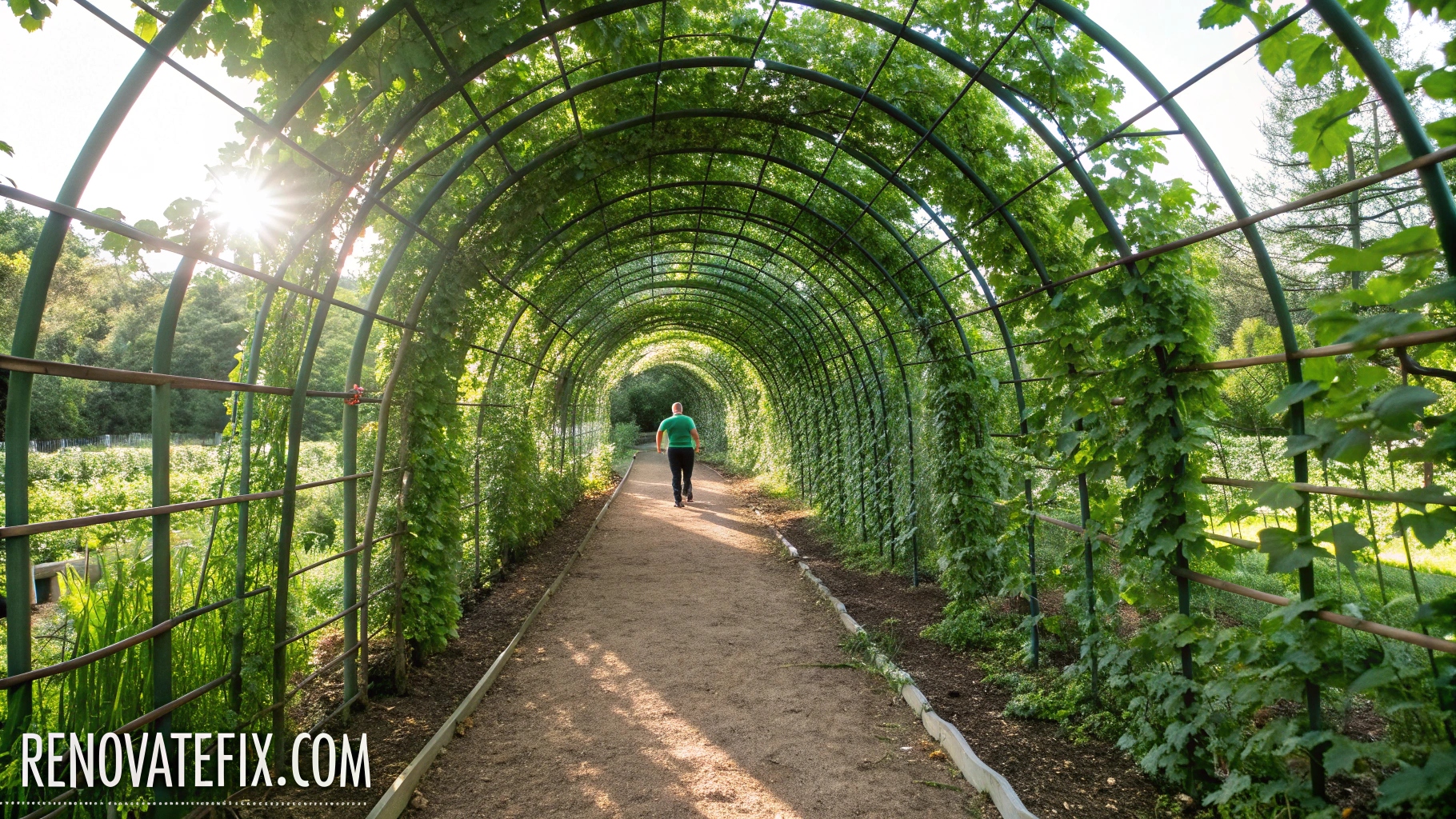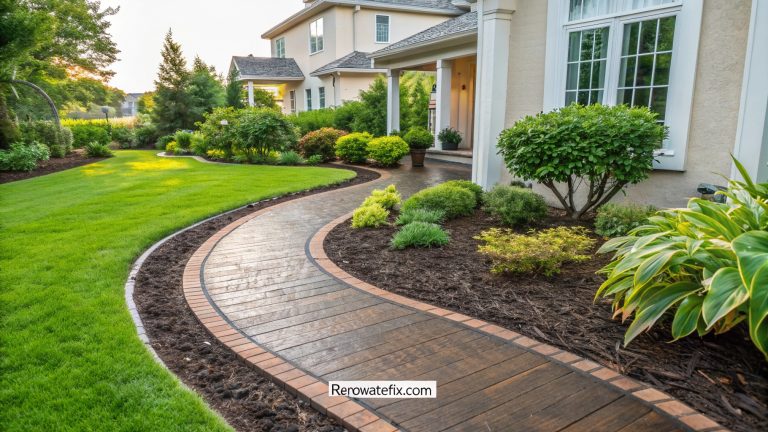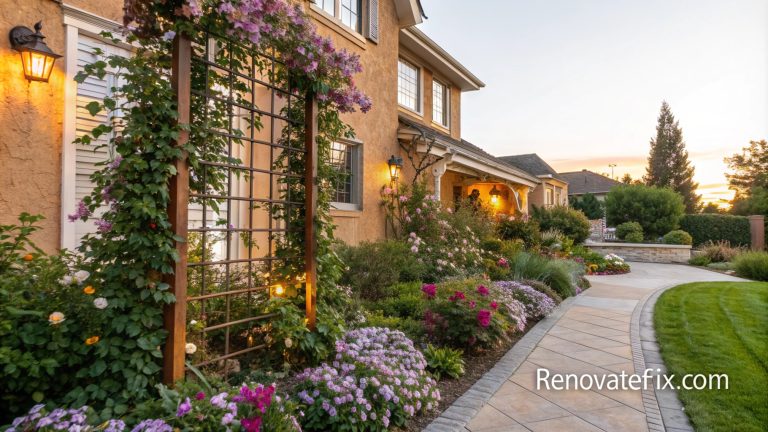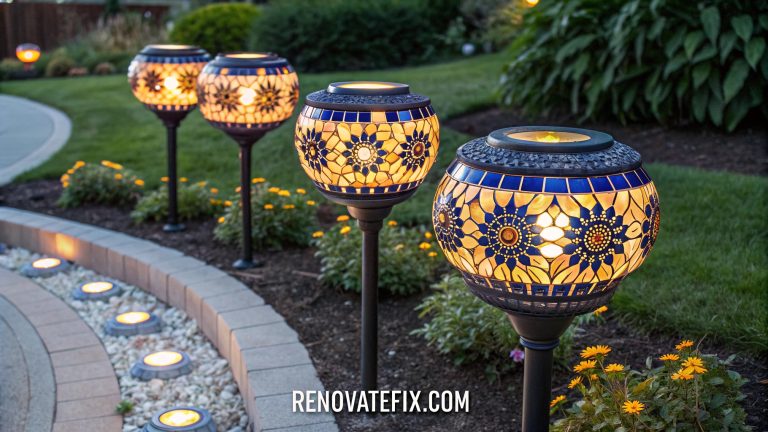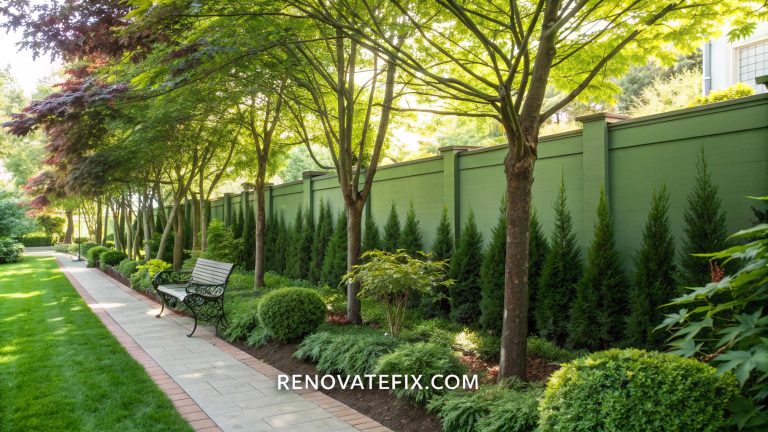Creative Pea Trellis Ideas for Your Garden
Peas are magnificent climbing plants that reward gardeners with sweet, nutritious harvests while adding vertical interest to garden spaces.
However, successful pea cultivation depends heavily on proper support structures. A well-designed pea trellis not only maximizes growing space but also improves air circulation, makes harvesting easier, and can become a stunning focal point in your garden landscape.
Whether you’re working with limited space or looking to enhance your garden aesthetics, this guide explores twenty innovative pea trellis concepts that balance functionality with visual appeal.
From repurposed materials to architectural designs, these ideas will inspire you to create the perfect climbing support for your pea plants while adding distinctive character to your growing area.
15 Creative Pea Trellis Ideas
1. Bamboo Teepee Structure
Bamboo poles arranged in a conical fashion create a sturdy yet visually appealing support system for climbing peas.
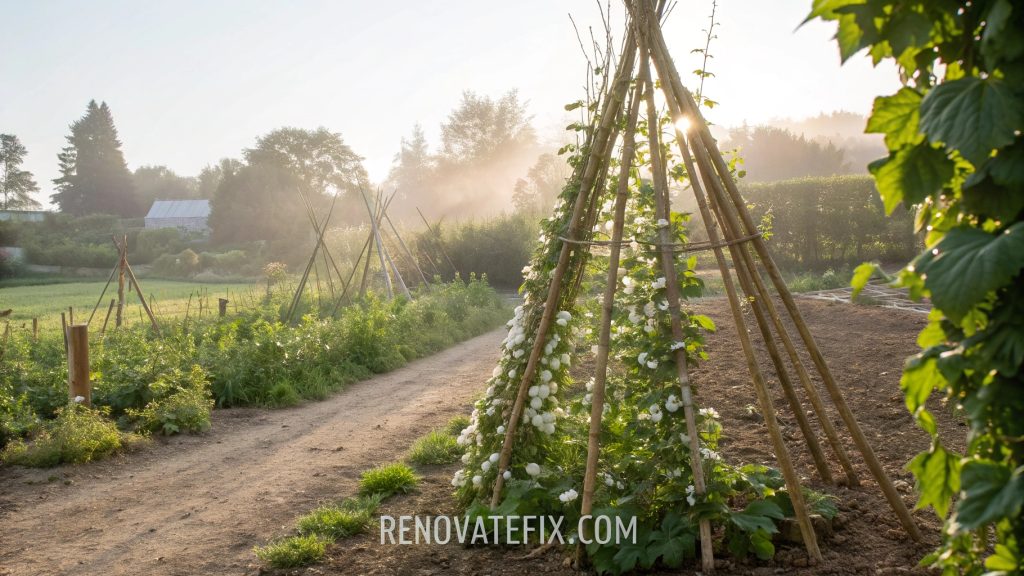
Gather six to eight poles approximately eight feet long, secure them at the top with garden twine or wire, and spread the bases in a circle around your pea plants.
Add horizontal twine between poles to provide additional climbing surfaces for tendrils to grasp as they reach skyward, forming a natural green pyramid that stands as an architectural element within garden rows.
2. Repurposed Ladder Framework
An old wooden ladder, stationed horizontally above pea seedlings, delivers practical climbing support with rustic charm.

Position it approximately twelve inches above soil level using sturdy posts at each end, allowing young pea shoots to reach upward naturally.
As vines ascend through and around rungs, they create a living archway of green foliage dotted with white blossoms and dangling pods, perfect for gardens where functionality meets countryside aesthetics.
3. Cattle Panel Arch Pathway
Curved cattle panels form magnificent walkway arches while providing optimal climbing space for prolific pea varieties.
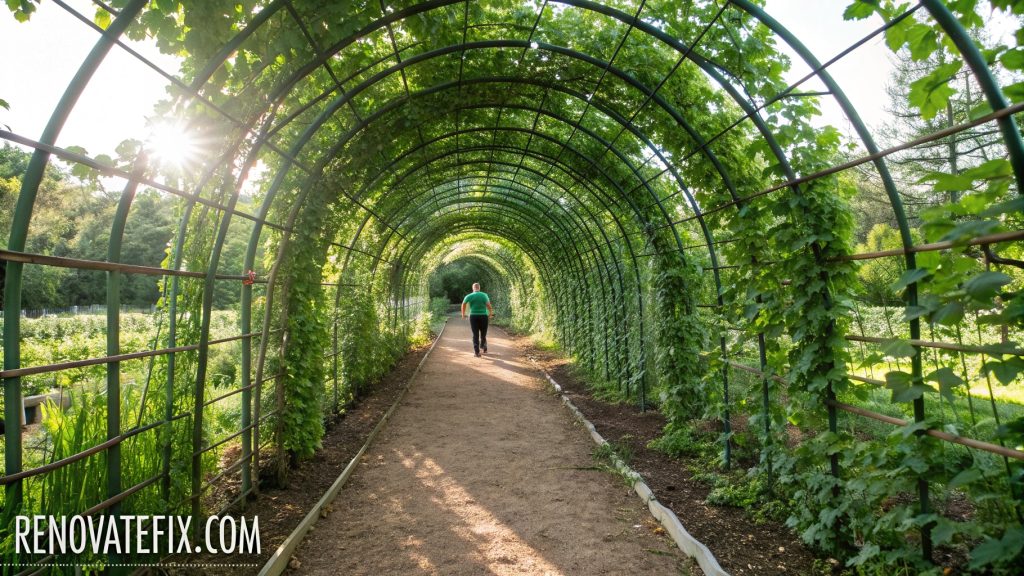
Secure two sixteen-foot panels into curved positions spanning garden paths, anchoring ends firmly into soil.
Pea vines eagerly climb these galvanized grid structures, eventually creating living tunnels dense with foliage and produce, offering both practical growing solutions and immersive garden experiences as you walk beneath canopies of fragrant pea blossoms.
4. String Grid System
Vertical strings arranged in grid patterns between wooden frames offer minimalist yet effective climbing support for delicate pea tendrils.
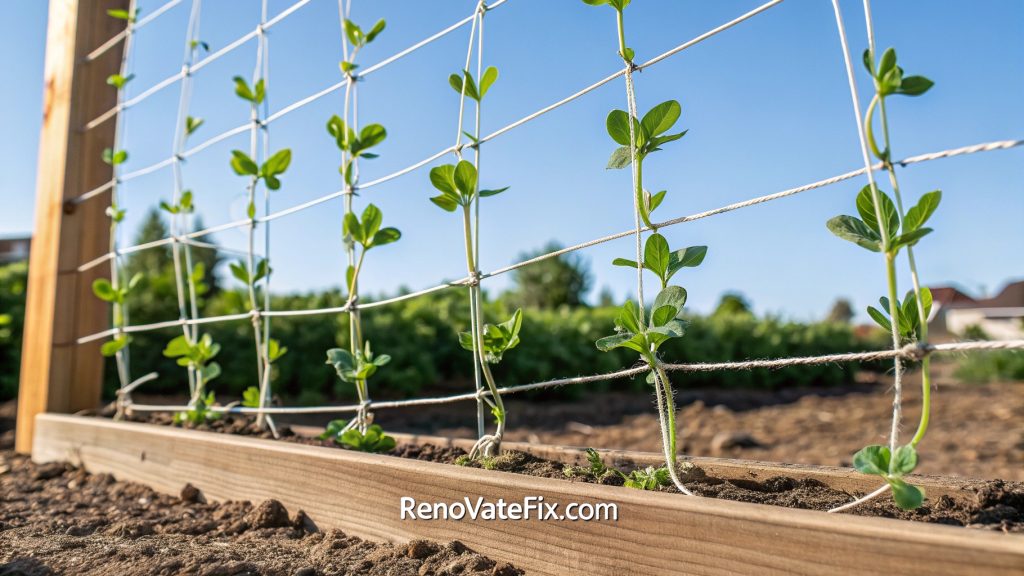
Construct simple frames using cedar posts at corners with horizontal supports top and bottom, then run cotton twine or garden string vertically at four-inch intervals.
Peas naturally wind around these thin supports, creating walls of green productivity that maintain clean linear aesthetics while maximizing growing space in orderly garden layouts.
5. Woven Willow Fence Panel
Handcrafted willow branches woven horizontally between vertical supports create living artwork that doubles as functional climbing structures.
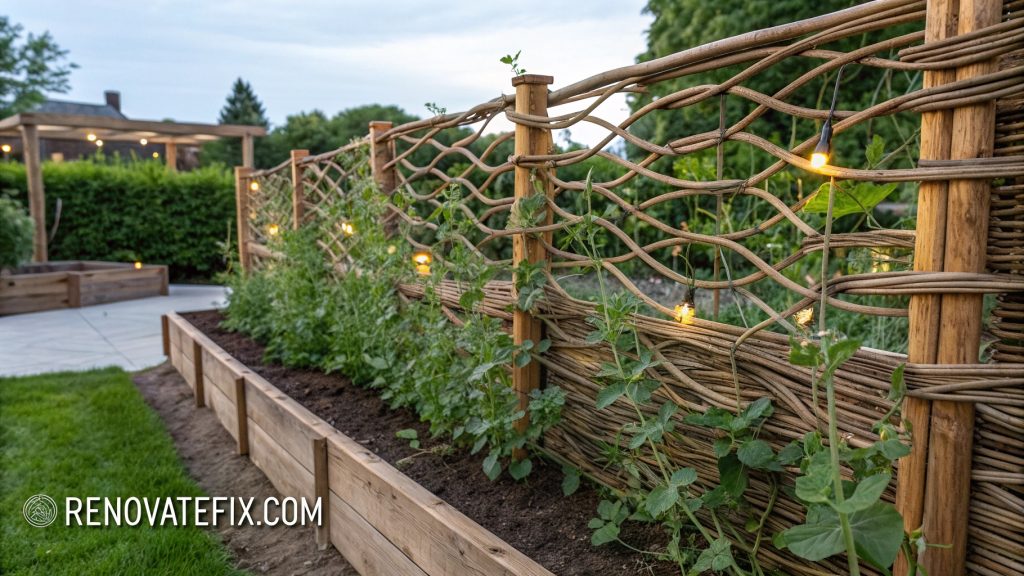
Harvest flexible willow rods during dormant seasons, weaving them through upright posts placed along pea rows at eighteen-inch intervals.
Natural variations in willow thickness and curvature provide countless attachment points for climbing peas, resulting in beautiful organic screens that blend perfectly with landscape designs while supporting bountiful harvests.
6. Bicycle Wheel Spirals
Salvaged bicycle wheels mounted vertically on metal poles create circular climbing structures with industrial flair.
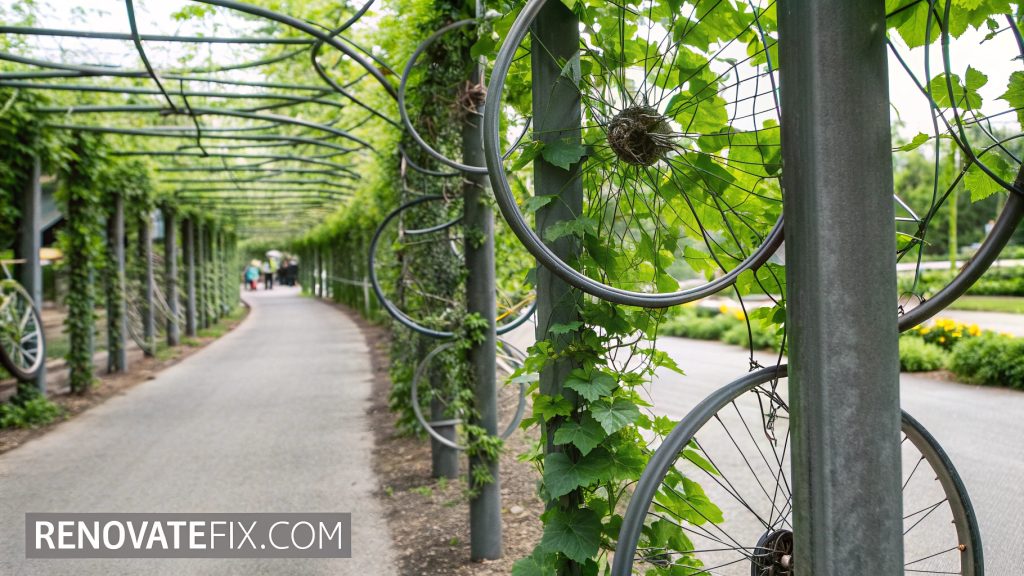
Remove tires from wheels, secure each wheel to a central metal pole inserted deeply into garden soil, and position several wheels at varying heights.
Pea tendrils eagerly grasp spokes and rims, forming spiral patterns of growth that showcase sustainability through creative reuse while providing excellent support for vigorous climbing varieties.
7. Branch Tepee Collection
Gathered fallen branches arranged into multiple small tepees create natural habitats for climbing peas with zero environmental impact.
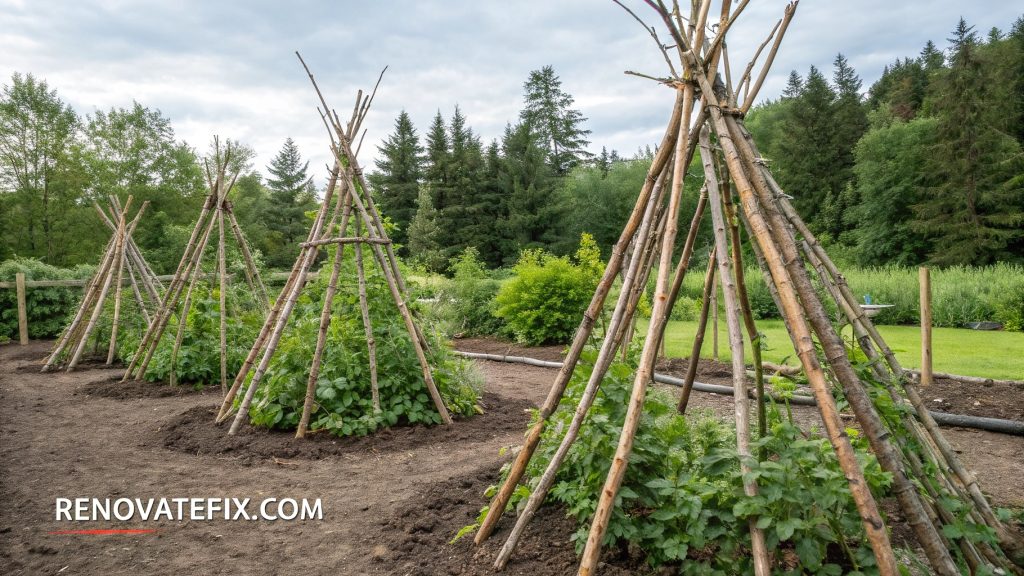
Select straight branches approximately four feet long, arrange five or six into conical structures, and secure tops with biodegradable twine before embedding bases into soil around pea seedlings.
Clusters of these branch tepees form sculptural elements throughout garden beds while supporting abundant pea growth on materials nature freely provides.
8. Mesh Panel Dividers
Concrete reinforcing mesh panels installed vertically along garden rows function as productive living walls between garden sections.
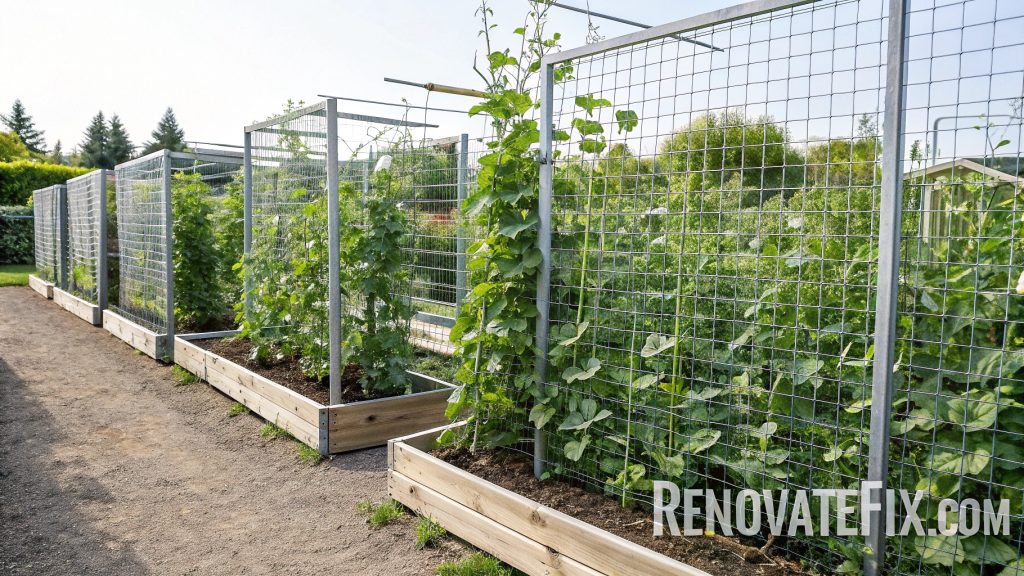
Cut panels to desired heights, secure with metal stakes driven deeply into soil, and position seedlings directly beneath.
Peas quickly ascend these rigid grid structures, thriving against substantial support that withstands weather challenges while creating distinct boundaries that organize garden spaces through productive green divisions rather than static barriers.
9. Driftwood Frame Construction
Weather-worn driftwood pieces assembled into free-form frames offer sculptural support with coastal inspiration.
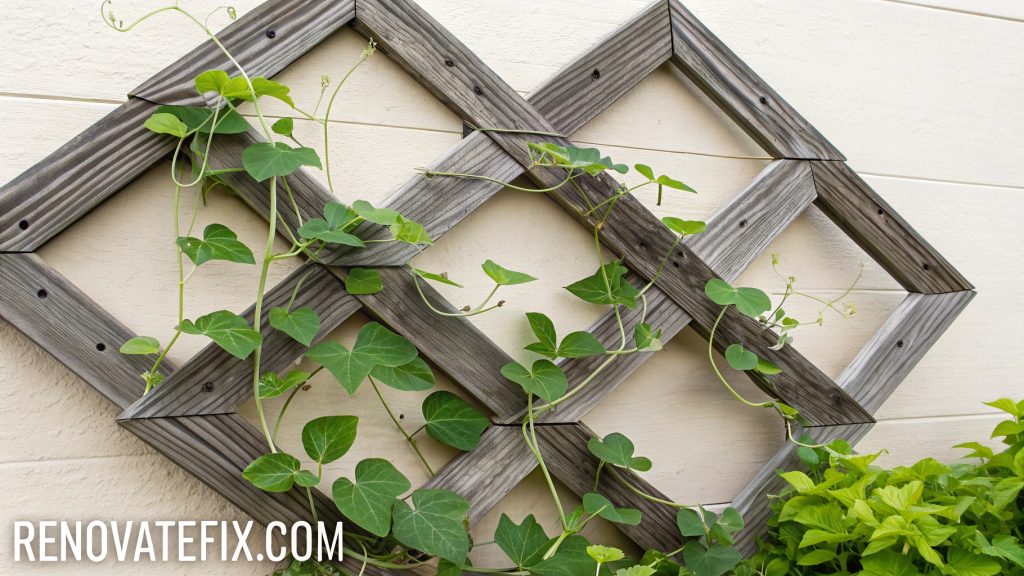
Select varied driftwood sections, secure with hidden screws or wire at connecting points, and anchor completed frames firmly alongside pea rows.
Silvery wood tones contrast beautifully with vibrant green pea foliage, creating garden focal points that celebrate nature’s artistic processes while providing irregular climbing surfaces that pea tendrils particularly enjoy grasping.
10. Wire Hoop Tunnel
Flexible wire hoops arranged sequentially create charming tunnels perfect for supporting peas while maximizing narrow spaces.

Form heavy gauge wire into half-circles, insert ends deeply into soil at twelve-inch intervals along rows, then connect hoops with horizontal wires.
Peas climb enthusiastically across these arched frameworks, forming living roofs dense with pods hanging perfectly for convenient harvesting from both sides of row systems.
11. Vintage Bed Spring Support
Reclaimed metal bed springs mounted vertically offer whimsical climbing structures with perfect coil spacing for pea tendrils.
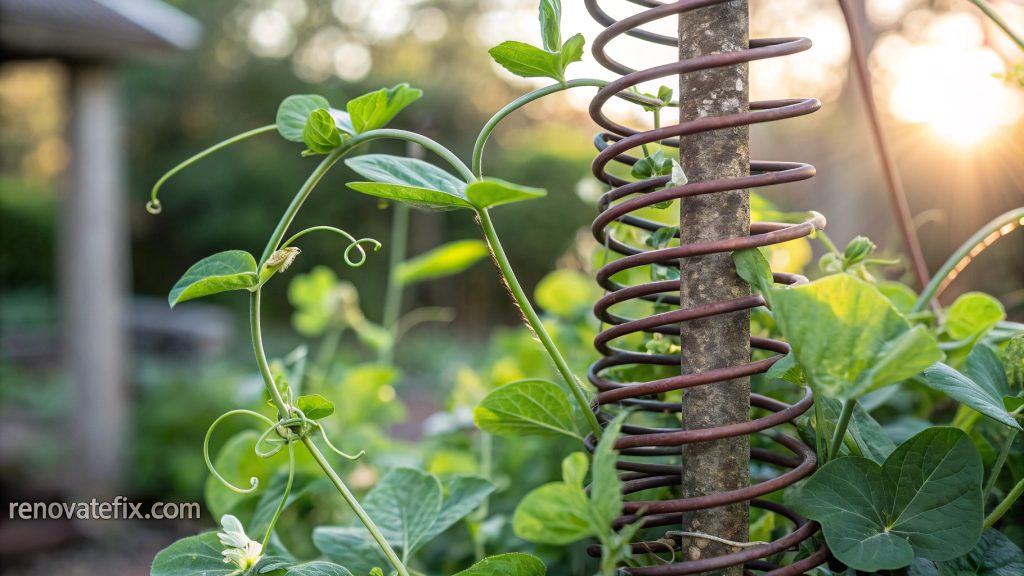
Secure old springs to sturdy posts driven into garden soil, positioning several springs in sequence to support entire pea rows.
Intricate coil patterns quickly disappear beneath vigorous pea growth, revealing only hints of their unusual underpinnings while demonstrating creative reuse principles and providing excellent vertical growing space within compact garden footprints.
12. Fallen Tree Branch Lattice
Reclaimed tree branches arranged in crisscross patterns between posts create natural lattice structures with woodland character.
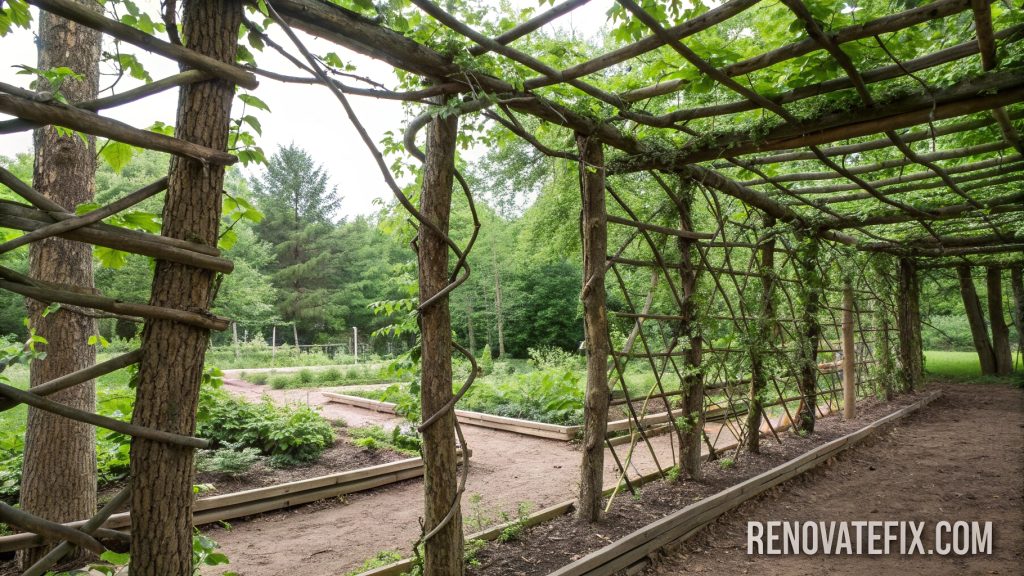
Select straight branches varying in diameter, arrange in grid patterns between upright supports, and secure with garden wire where pieces intersect.
Peas climb eagerly across these rustic frameworks, their tendrils wrapping around varying branch textures to create productive living walls that harmonize perfectly with naturalistic garden designs.
13. Copper Pipe Geometric Frame
Polished copper pipes assembled into architectural geometric patterns create striking modern support structures that patina beautifully over seasons.
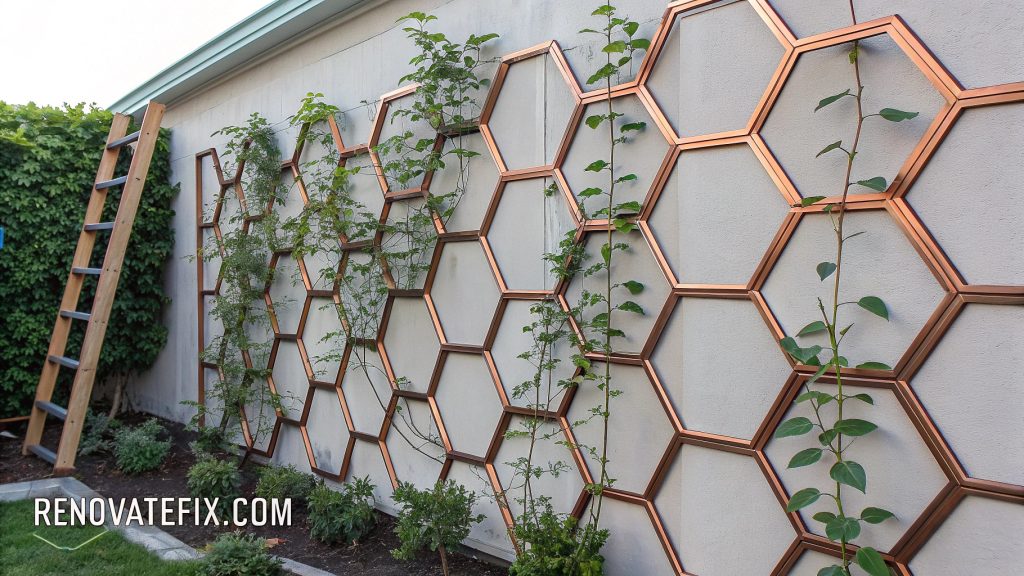
Cut pipes to desired lengths, connect with appropriate fittings to form triangular or hexagonal repeated patterns, and anchor completed frames alongside pea rows.
Copper’s evolving surface provides magnificent contrast against green foliage, offering garden statements that balance artistic design with practical growing support throughout productive seasons.
14. Fabric Strip Weaving
Colorful fabric strips woven through sturdy frames transform basic trellises into textile-inspired garden art supporting vigorous pea growth.
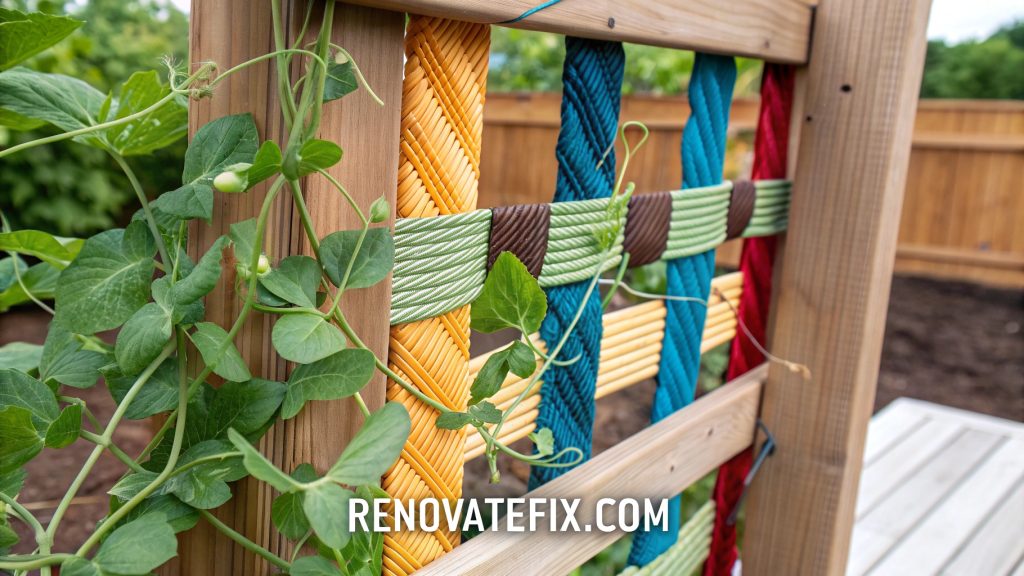
Construct simple wooden frames, then weave weather-resistant fabric strips in appealing patterns across openings, creating semi-solid panels.
Pea tendrils navigate these woven landscapes eagerly, eventually covering frameworks with productive growth while allowing glimpses of fabric patterns beneath, uniting gardening with fiber arts traditions.
15. Stone Stack Column Supports
Stacked stone columns connected by horizontal supports combine ancient building techniques with practical growing solutions.

Carefully balance flat stones into three-foot columns spaced along pea rows, connect tops with wooden crosspieces, and run vertical strings between supports.
These substantial structures anchor garden designs while providing excellent climbing opportunities, merging traditional stonework aesthetics with productive gardening methods for striking results.
16. Rope Macramé Hanging System
Intricate rope macramé panels suspended between posts create artistic vertical gardens with excellent climbing support.
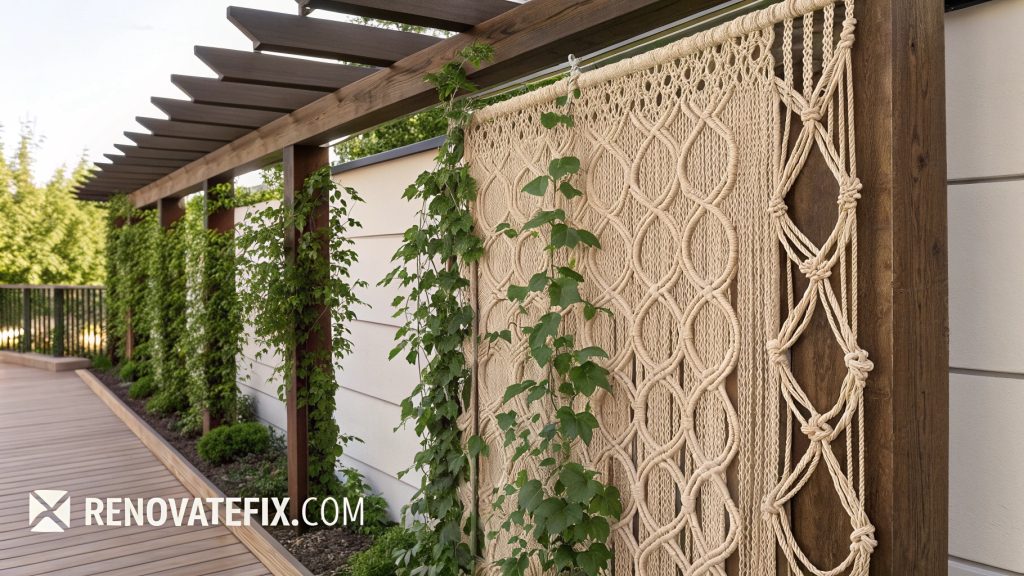
Craft macramé panels using weather-resistant rope, incorporating various knot patterns that provide numerous attachment points for plant tendrils.
Hang completed works between garden posts, positioning pea seedlings beneath.
As vines ascend these tactile surfaces, they integrate completely with knotted designs, blending handcraft traditions with productive gardening practices.
17. Wood Pallet Vertical Frame
Dismantled wooden pallets reconstructed into A-frame structures offer substantial climbing support with upcycled materials.
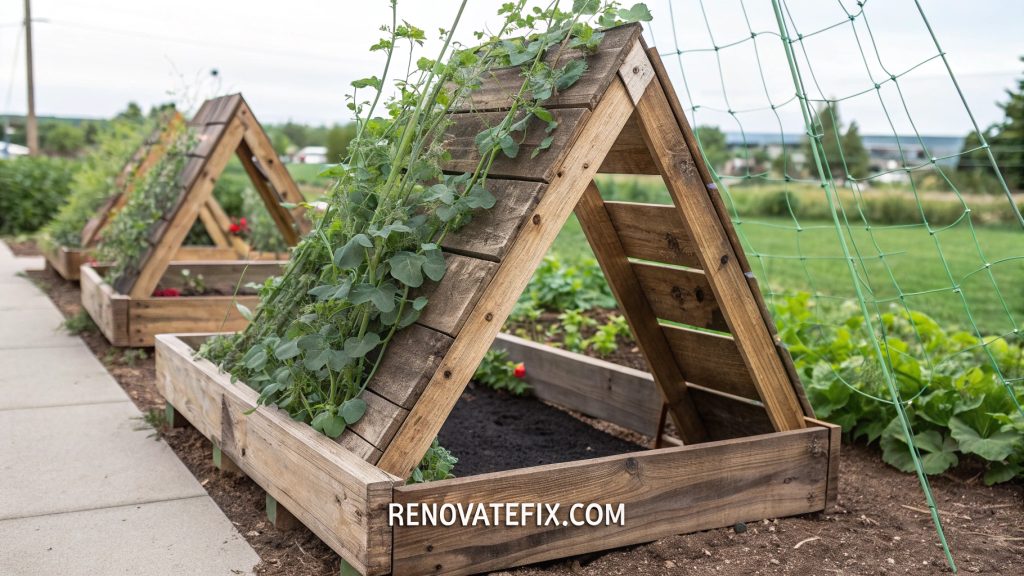
Break down pallets, maintain plank spacing when reassembling into triangular frames, and position over pea rows.
Weathered wood gains new purpose as peas climb enthusiastically across these frameworks, demonstrating resource conservation while providing perfect growing environments within rustic garden aesthetics focused on functionality.
18. Garden Tool Hanging Rack
Obsolete garden tools mounted horizontally create whimsical climbing supports celebrating gardening heritage.
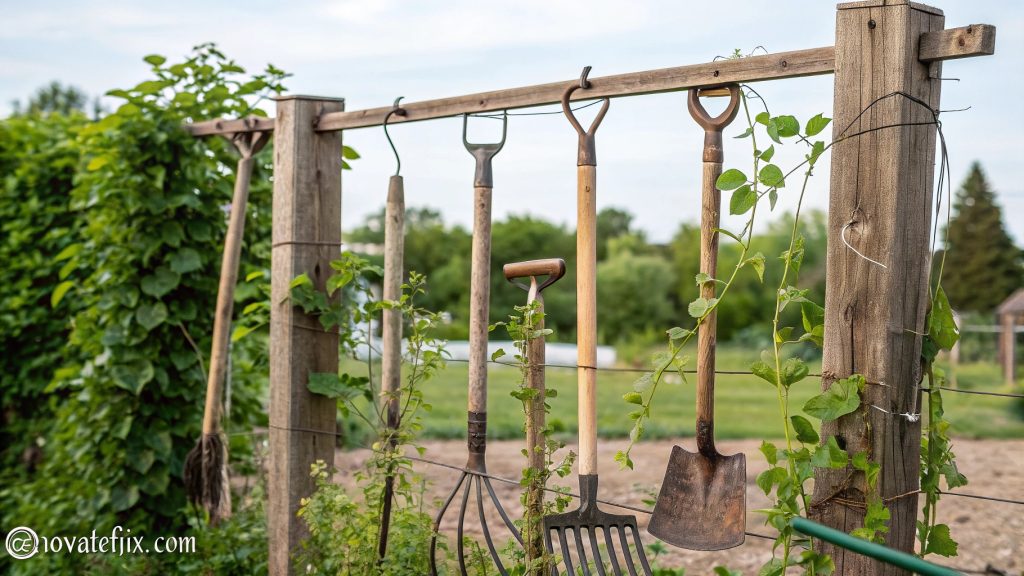
Attach old rake heads, hoe blades, and tool handles to sturdy posts, positioning them at varying heights to create irregular climbing surfaces.
Peas twist happily through these unconventional structures, transforming gardening history into productive present use while creating conversation pieces that showcase gardener creativity and resourcefulness.
19. Wicker Panel Screens
Handwoven wicker panels installed between posts deliver natural textural supports perfect for delicate pea tendrils.
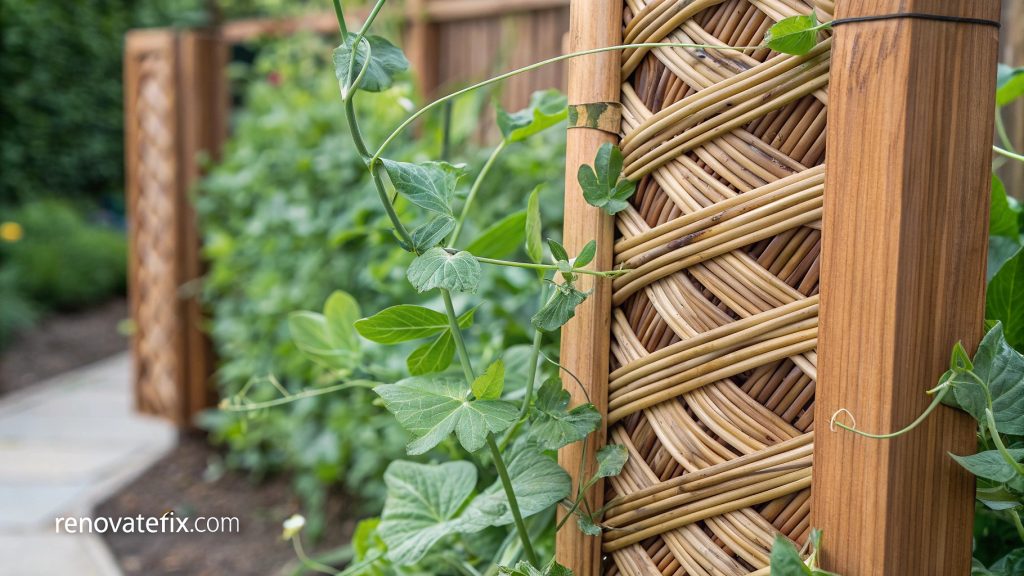
Position ready-made panels or weave your own using willow or reed materials, securing between robust garden posts along pea rows.
Peas navigate these woven landscapes eagerly, their tendrils finding countless attachment points across natural fiber surfaces that add warm textural elements to garden designs.
20. Vertical PVC Pipe Garden
Drilled PVC pipes mounted vertically combine growing support with water distribution innovation.

Secure eight-foot lengths of four-inch PVC pipe to sturdy posts, drill half-inch holes throughout pipe surfaces, and plant peas around bases.
Vines climb naturally up pipe exteriors while benefiting from water poured directly into pipe tops, creating efficient growing systems particularly valuable during dry seasons when moisture conservation becomes crucial to continued productivity.
Conclusion
These twenty pea trellis designs demonstrate how functional growing structures can simultaneously serve as garden focal points while supporting abundant harvests.
Beyond merely providing climbing support, each trellis concept adds unique character to garden spaces, showcasing how practical growing requirements can inspire creative solutions.
Whether your priority is maximizing limited space, repurposing available materials, or creating artistic garden statements, there’s a pea trellis approach perfectly suited to your needs.
As your peas climb skyward on these innovative structures, you’ll enjoy not only the practical benefits of improved growing conditions and easier harvesting but also the visual satisfaction of vertical garden elements that transform ordinary vegetable patches into extraordinary growing spaces.
Remember that the most successful trellises balance sturdy support with adequate climbing surfaces while complementing your overall garden aesthetic, allowing peas to thrive while enhancing your garden’s visual appeal.

